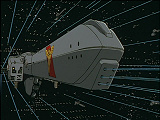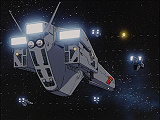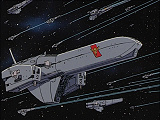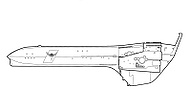Beowulf
From Gineipaedia, the Legend of Galactic Heroes wiki
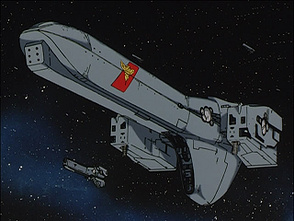 The flagship Beowulf (800 UC (2 NIC / 491 IC / 3600 CE)) | |
| Affiliation: | Galactic Empire |
| Flag officer: | Fleet Admiral Mittermeyer |
| Type: | Battleship |
| Purpose: | Flagship (Mittermeyer Fleet) |
| Length: | 988 metres(FFC6) |
| Width: | 242 metres(FFC6) |
| Height: | 248 metres(FFC6) |
| Armament: | 6 forward cannons 20 port cannons 20 starboard cannons |
| Crew: | 954(FFC6) |
| Status: | Active |
The Beowulf (Japanese: 人狼) was the Imperial flagship of Admiral Wolfgang Mittermeyer.
Contents |
Service history
Alliance–Imperial War
The Beowulf's first campaign as the head of the Mittermeyer Fleet was in Reinhard von Lohengramm's campaign to defeat the Free Planets Alliance's invasion of Imperial space in 796 UC (487 IC / 3596 CE), defeating the 9th Fleet in the Alviss System. At the subsequent Battle of Amritsar Starzone, the Beowulf's port hull was damaged by fire from the 13th Fleet. (LOGH: 'The Battle of Amritsar Starzone').
Imperial Civil War
The Beowulf served at the forefront of Lohengramm's campaign against the Lippstadt League in the Imperial Civil War in 797 UC (488 IC / 3597 CE), including defeating the fleet of AdmiralStaden, and spearheading the effort to capture Rentenberg Fortress. In particular, the Beowulf was instrumental in drawing the main rebel forces out of Geiersburg Fortress, where they were decisvely defeated. (LOGH: 'Bloodshed in Space', 'Courage and Loyalty')
Invasion of the Alliance
With the resumption of hostilities against the Alliance, the Beowulf was engaged in the major battles of 798 UC (489 IC / 3598 CE) to 799 UC (1 NIC / 490 IC / 3599 CE), with High Admiral Mittermeyer battling elements of the Yang Fleet in the aftermath of the Eighth Battle of Iserlohn, and forming the spearhead of the massive fleet that invaded the Fezzan Corridor and conquered Fezzan. (LOGH: 'Determination and Ambition', 'Fezzan Occupied')
Following the takeover of Fezzan, the Beowulf fought at the Battle of Rantemario, with the Mittermeyer Fleet forming the centre of Lohengramm's battle formation. Opening the battle with a charge, the sight of the Beowulf caused the Alliance Fleet to launch a panicked attack. (LOGH: 'The Two-Headed Snake: The Battle of Rantemario')
In the lead-up to the Battle of Vermilion in 799 UC (1 NIC / 490 IC / 3599 CE), Mittermeyer took his fleet to an Alliance supply base in the Eleuthera Starzone, in accordance with Lohengramm's plan. On the advice of Hildegard von Mariendorf, Mittermeyer then joined the Reuenthal Fleet in attacking Heinessen to force an Alliance surrender. As a demonstration, the Beowulf destroyed the Strategical Planning Centre. (LOGH: 'Sudden Change')
Second Alliance-Imperial War
The Beowulf re-opened hostilities later in 799 UC (1 NIC / 490 IC / 3599 CE), leading its fleet in an attack on Planet Lusiana. It also participated at the Battle of Marr-Adetta Starzone in January 800 UC (2 NIC / 491 IC / 3600 CE), charging in the late stages of the battle to split the forces of Fleet Admiral Bewcock in two. During the Battle of the Corridor in May 800 UC (2 NIC / 491 IC / 3600 CE), the Beowulf suffered damage to its starboard hull, resulting in an erroneous report that Fleet Admiral Mittermeyer had been killed. The report was soon proven false, but the damage sustained forced Mittermeyer to withdraw from the front lines. (LOGH: 'The Battle of the Corridor: End of the Campaign')
Reuenthal's Rebellion & The Battle of Shiva
The Beowulf led the Mittermeyer Fleet against Fleet Admiral Reuenthal's rebel forces in late 800 UC (2 NIC / 491 IC / 3600 CE) at the Second Battle of Rantemario, and then the final Battle of Shiva in mid 801 UC (3 NIC / 492 IC / 3601 CE). (LOGH: 'The Two Great Ones Strike at Each Other!', 'The Crimson Star Road')
Design
The Beowulf is very similar to the Tristan in design, reflecting the friendship between Mittermeyer and Oskar von Reuenthal, the 'twin stars' of Reinhard von Lohengramm's Admiralty.
Gallery
Prow (801 UC (3 NIC / 492 IC / 3601 CE)) |
Stern (800 UC (2 NIC / 491 IC / 3600 CE)) |
Starboard (800 UC (2 NIC / 491 IC / 3600 CE)) |
Appendices
Appearances
- LOGH:
- 'The Battle of Amritsar Starzone' (first appearance)
- 'The Lippstadt Conspiracy'
- 'Bloodshed in Space'
- 'Courage and Loyalty'
- 'Farewell, Distant Memories'
- 'Determination and Ambition'
- 'The Sounding of Gjallarhorn'
- 'Fezzan Occupied'
- 'The Cold Spell Arrives'
- 'Seeking a Free Universe'
- 'The Two-Headed Snake: The Battle of Rantemario'
- 'Sudden Change'
- 'Long Live the Emperor!'
- 'Against All Flags'
- 'Ragnarök Again'
- 'To El Facil'
- 'The Battle of Marr-Adetta Starzone (Part One)'
- 'The Battle of Marr-Adetta Starzone (Part Two)'
- 'Eve of the Festival'
- 'To the Windy Corridor'
- 'The Battle of the Corridor: Kaleidoscope'
- 'The Battle of the Corridor: End of the Campaign'
- 'Disappointing Victory'
- 'The Order to Transfer the Capital'
- 'Premonition of a Storm'
- 'Rebellion Is a Hero's Privilege'
- 'The Two Great Ones Strike at Each Other!'
- 'Live by the Sword...'
- 'Die by the Sword'
- 'Endless Requiem'
- 'Running Start Towards the Future'
- 'Invitation to Rebellion'
- 'Cosmic Mosaic'
- 'Planet of Confusion'
- 'Dream: To See It to the End' (last appearance)
Name variations
- Beowulf (DVD subtitles)
- Beiowolf (LD subtitles)
- 人狼 (LD/DVD subtitles - Japanese)
Licensed Sources
At the very rear of the ship was a pair of domes underneath the central engine. This was a laser system used to dispose of waste heat. The Tristan had a similar system, but mounted 1 large unit as compared to the 2 smaller units on the Beowulf. (Fleet File Collection Vol.8)
Background information
The name Beowulf is derived from the Old English heroic epic poem of the same name. There is a divergence in meaning from the Japanese kanji 人狼 means "werewolf".
Apocrypha
Fleet File Collection
The Beowulf is included as a model (with both Goldenbaum and Goldenlöwe markings) in Fleet File Collection Vol.6. In a 'Reader Memo' it is mentioned that it was decided during the making of the series that the Beowulf would have straight hull lines to reflect Mittermeyer's character while similarly the Tristan would reflect Reuenthal's "sexy" image with more curved hull lines, evoking the curved contours of a woman's body.
| v•d•e | |
|---|---|
| Asgrimm • Audhumla • Augsburg • Barbarossa • Beowulf • Bergelmir • Berlin • Brünhild • Dagda • Diarium • Eistla • Embla • Forseti • Garga Falmul • Göttingen • Grendel • Heidenheim • Helten • Heorot • Heremoss • Jotunheim • Königs Tiger • Kvasir • Kücrain • Langenberg • Lübeck • Morholt • Neustadt • Nördlingen • Nürnberg • Offenburg • Ostfalen • Ostmark • Perceval • Quermark • Salamander • Sindur • Skirnir • Tannhäuser • Theodoricus • Tristan • Ulfrun • Vanadis • Valendown • Vigrissr • Vissarr • Vonkel • Watzmann • Wilhelmina | |
